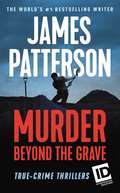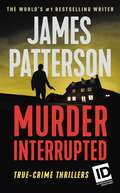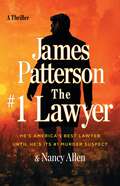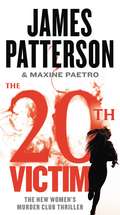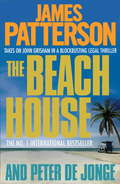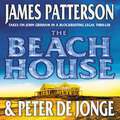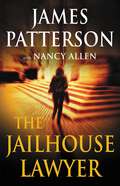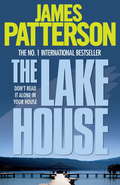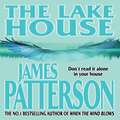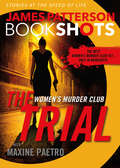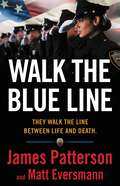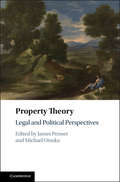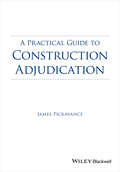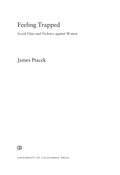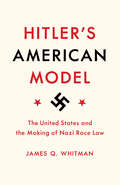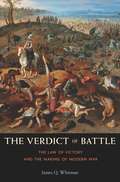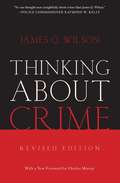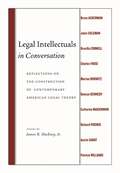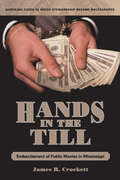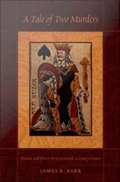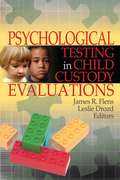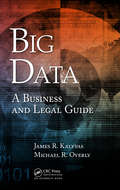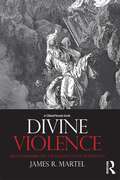- Table View
- List View
Murder Beyond the Grave: True-crime Thrillers (James Patterson's Murder is Forever #3)
by James Patterson<P>Two true-crime thrillers as seen on Discovery's Murder is Forever TV series - premiering February 2018 <P>MURDER BEYOND THE GRAVE. <P>Stephen Small has it all-a Ferrari, fancy house, loving wife, and three boys. But the only thing he needs right now is enough air to breathe. Kidnapped, buried in a box, and held for ransom, Stephen has forty-eight hours of oxygen. The clock is ticking . . . <P>MURDER IN PARADISE. <P>High in the Sierra Nevada mountains, developers Jim and Bonnie Hood excitedly tour Camp Nelson Lodge. They intend to buy and modernize this beautiful rustic property, but the locals don't like rich outsiders changing their way of life. After a grisly shooting, everybody will discover just how you can make a killing in real estate . . . <P><b>A New York Times Bestseller</b>
Murder, Interrupted: True-crime Thrillers (James Patterson's Murder is Forever #1)
by James PattersonTwo true-crime thrillers as seen on Discovery's Murder is Forever TV series - premiering January 2018MURDER, INTERRUPTED. Rich, cheating financier Frank Howard wants his wife dead, and he's willing to pay Billie Earl Johnson whatever it takes, to the tune of $750,000. When his bullet misses the mark, Billie Earl and Frank will turn on each other in a fight for their lives . . . MOTHER OF ALL MURDERS. Dee Dee Blancharde is a local celebrity. Television reports praise her as a single mother who tirelessly cares for her wheelchair-bound, chronically ill daughter. But when the teenaged Gypsy Rose realizes she isn't actually sick and Dee Dee has lied all these years, Gypsy Rose exacts her revenge . . .
The #1 Lawyer
by James Patterson Nancy AllenBiloxi’s best criminal defense attorney has never lost a case. Then his client’s beautiful wife is murdered, and America’s #1 lawyer suddenly becomes its #1 suspect. <p><p> Stafford Lee Penney is a small-town lawyer with a big-time reputation for winning every case he tries. In his sharp suits and polished Oxford shoes, Penney is Biloxi, Mississippi’s #1 Lawyer and top local celebrity. <p><p> Just as Penney notches his latest courtroom victory, his wife is scandalously killed. He spirals into a legal and personal losing streak, damaging his reputation and ruining his career. <p><p> That’s when Penney makes a bold decision. He stops trading on his power-lawyer identity and creates a new one: lawyer lifeguard. Moonlighting at the beach, showing up to court in flip-flops, mentoring a law student, the new Penney is at first unrecognizable. <p><p> It’s said that a lawyer who represents himself has a fool for a client. But when Penney is accused of murder, the #1 Lawyer will find a way to triumph. <p> <b>New York Times Bestseller</b>
The 19th Christmas (Women's Murder Club #19)
by James Patterson Maxine PaetroIf the Women's Murder Club can't be together this Christmas, a killer is to blame. <P><P>As the holidays approach, Detective Lindsay Boxer and her friends in the Women's Murder Club have much to celebrate. Crime is down. The medical examiner's office is quiet. Even the courts are showing some Christmas spirit. And the news cycle is so slow that journalist Cindy Thomas is on assignment to tell a story about the true meaning of the season for San Francisco. <P><P>Then a fearsome criminal known only as "Loman" seizes control of the headlines. He is planning a deadly surprise for Christmas morning. And he has commissioned dozens of criminal colleagues to take actions that will mask his plans. All that Lindsay and the SFPD can figure out is that Loman's greed -- for riches, for bloodshed, for attention -- is limitless. <P><P>Solving crimes never happens on schedule, but as this criminal mastermind unleashes credible threats by the hour, the month of December is upended for the Women's Murder Club. Avoiding tragedy is the only holiday miracle they seek. <P><P><b>A New York Times Bestseller</b>
The 20th Victim (Women's Murder Club #20)
by James Patterson Maxine PaetroSergeant Lindsay Boxer tackles an ambitious case that spans San Francisco, L.A., and Chicago in this pulse-pounding thriller of "smart characters" and "shocking twists" (Lisa Gardner, #1 New York Times bestselling author). <p><p>Three victims, three bullets, three cities. The shooters' aim is as fearsomely precise as their target selection. When Lindsay realizes that the fallen men and women excel in a lucrative, criminal activity, she leads the charge in the manhunt for the killers. As the casualty list expands, fear and fascination with this suspicious shooting gallery galvanizes the country. <p><p>The victims were no angels, but are the shooters villains . . . or heroes? <p><p><b>A New York Times Bestseller</b>
The Beach House
by James Patterson Peter De JongeThe second that Columbia law student Jack Mullen steps down from the train at East Hampton, he knows that something is very wrong. As he greets his family, his kid brother Peter lies stretched out on a steel gurney, battered, bruised - dead. The police are calling the drowning an accident. Jack knows that's not right. Someone wanted his brother dead.But the establishment says otherwise. Jack tries to uncover what really happened on the beach that night, only to confront a wall of silence; a barricade of shadowy people who protect the privileges of the multi-billionaire summer residents. And when he discovers that his brother had nearly $200,000 in his bank account, Jack realises Peter wasn't just parking cars to make a living...
The Beach House
by James Patterson Peter De JongeThe second that Columbia law student Jack Mullen steps down from the train at East Hampton, he knows that something is very wrong. As he greets his family, his kid brother Peter lies stretched out on a steel gurney, battered, bruised - dead. The police are calling the drowning an accident. Jack knows that's not right. Someone wanted his brother dead.But the establishment says otherwise. Jack tries to uncover what really happened on the beach that night, only to confront a wall of silence; a barricade of shadowy people who protect the privileges of the multi-billionaire summer residents. And when he discovers that his brother had nearly $200,000 in his bank account, Jack realises Peter wasn't just parking cars to make a living...(P)2012 Headline Digital
The Jailhouse Lawyer
by James Patterson Nancy AllenFrom James Patterson, the world's #1 bestselling author: a young lawyer takes on the judge who is destroying her hometown—and ends up in jail herself. <P><P>In picture-perfect Erva, Alabama, the most serious crimes are misdemeanors. Speeding tickets. Shoplifting. Contempt of court. Then why is the jail so crowded? And why are so few prisoners released? There’s only one place to learn the truth behind these incriminating secrets. Sometimes the best education a lawyer can get is a short stretch of hard time. <P><P><b>A New York Times Best Seller</b>
The Lake House
by James PattersonFrannie O'Neill's life turned upside down when she and FBI maverick Kit Brennan rescued six incredible winged children from the school that created them. Now the young flock wants to go back to the couple, and Frannie and Kit are suing for custody. But when the case involves the most extraordinary creatures ever to land on this earth, someone will ensure there is no happy ending. Only Max, the most remarkable of the children, knows that another, terrifying biological experiment is taking place in the labs of a brilliant but evil surgeon, Dr Ethan Kane. But to complete his experiment he needs the ultimate prize - Max herself. And as the children dream of returning to the happy safety of the lake house, where for a few precious months they flew free, Kane moves ever closer...
The Lake House
by James PattersonFrannie O'Neill's life turned upside down when she and FBI maverick Kit Brennan rescued six incredible winged children from the school that created them. Now the young flock wants to go back to the couple, and Frannie and Kit are suing for custody. But when the case involves the most extraordinary creatures ever to land on this earth, someone will ensure there is no happy ending. Only Max, the most remarkable of the children, knows that another, terrifying biological experiment is taking place in the labs of a brilliant but evil surgeon, Dr Ethan Kane. But to complete his experiment he needs the ultimate prize - Max herself. And as the children dream of returning to the happy safety of the lake house, where for a few precious months they flew free, Kane moves ever closer...(P)2012 Headline Digital
The Trial: A BookShot (A Women's Murder Club Story #1)
by James Patterson Maxine Paetro<P>"I'm not on trial. San Francisco is." <P>An accused murderer called Kingfisher is about to go on trial for his life. Or is he? By unleashing unexpected violence on the lawyers, jurors, and police involved in the case, he has paralyzed the city. Detective Lindsay Boxer and the Women's Murder Club are caught in the eye of the storm. <P>Now comes a courtroom shocker you will never see coming.
Walk the Blue Line: No right, no left—just cops telling their true stories to James Patterson. (Heroes Among Us #3)
by James Patterson Matt EversmannFrom the #1 New York Times bestselling authors of Walk in My Combat Boots: true-life stories from the men and women who protect and serve our homes, families and communities.Protect These men and women are our eyes. Our ears. Our protectors. Those who wear a badge, doing their best to help people. Serve These cops serve their communities. They serve their country. They&’re in the business of saving lives—even at the risk of their own. Defend These patrol officers and K9 handlers, sheriffs and detectives, reveal what it&’s really like to wear the uniform, to carry the weight of the responsibility they&’ve been given. This is a calling. This is the job.&“Walk the Blue Line is the book that the law-enforcement community has been waiting for. These stories showcase the courage, the hurt, the anger and the joy that can be found in every officer&’s DNA—and above all, their commitment to making difficult situations a little bit better." —Jim Pasco, Executive Director, National Fraternal Order of Police
Property Theory: Legal and Political Perspectives
by James Penner Michael OtsukaProperty, or property rights, remains one of the most central elements in moral, legal, and political thought. It figures centrally in the work of figures as various as Grotius, Locke, Hume, Smith, Hegel and Kant. This collection of essays brings fresh perspective on property theory, from both legal and political theoretical perspectives, and is essential reading for anyone interested in the nature of property. Edited by two of the world's leading theorists of property, James Penner and Michael Otsuka, this volume brings together essays which consider, amongst other topics, property and public law, the importance of legal forms in property theory, whether use or exclusion are most essential to our understanding of property, distributive justice, Lockean and Grotian theories, the common ownership of the Earth, and Confucian ideas of property.
A Practical Guide to Construction Adjudication
by James PickavanceIn the United Kingdom, adjudication is available as a right for parties to a construction contract, following the enactment of the Housing Grants Construction and Regeneration Act 1996. In general, within a comparatively short period of time, parties in dispute will have a decision from an adjudicator, which, except in limited circumstances, the courts will enforce. Adjudication has become the number one method of dispute resolution in the construction industry. The short timescale means that a party needs to know what to do, when to do it and be able to check that the other party and the adjudicator are following the right steps. A Practical Guide to Construction Adjudication gives parties the necessary information to achieve this. It provides a straightforward overview of the process and procedure of adjudication by reference to legislation and case law, augmented with practical guidance including suggestions on what to do or not to do, drafting tips and checklists. Separate chapters for Scotland and Northern Ireland identify and explain the differences in procedure and judicial interpretation between those jurisdictions and England and Wales, and further detailed explanations of the adjudication regimes in Australia, Ireland, Malaysia, New Zealand and Singapore are included. Each of the chapters on jurisdictions outside England and Wales has been written by senior experts in those jurisdictions to ensure the content is accurate and insightful. There are a range of helpful appendices including a bank of model form adjudication documents and tabulated detailed comparisons of the Scheme for Construction Contracts, the other major adjudication rules, the major adjudicator nominating bodies and the UK and international regimes. Readers will particularly appreciate the most comprehensive index of adjudication cases available, sorted into 260 subject headings providing immediate access to all the reported cases on any adjudication topic.
Feeling Trapped: Social Class and Violence against Women (Gender and Justice #9)
by James PtacekThe relationship between class and intimate violence against women is much misunderstood. While many studies of intimate violence focus on poor and working-class women, few examine the issue comparatively in terms of class privilege and class disadvantage. James Ptacek draws on in-depth interviews with sixty women from wealthy, professional, working-class, and poor communities to investigate how social class shapes both women's experiences of violence and the responses of their communities to this violence. Ptacek's framing of women's victimization as "social entrapment" links private violence to public responses and connects social inequalities to the dilemmas that women face.
Hitler's American Model: The United States and the Making of Nazi Race Law
by James Q. WhitmanNazism triumphed in Germany during the high era of Jim Crow laws in the United States. Did the American regime of racial oppression in any way inspire the Nazis? The unsettling answer is yes. In Hitler's American Model, James Whitman presents a detailed investigation of the American impact on the notorious Nuremberg Laws, the centerpiece anti-Jewish legislation of the Nazi regime. Contrary to those who have insisted that there was no meaningful connection between American and German racial repression, Whitman demonstrates that the Nazis took a real, sustained, significant, and revealing interest in American race policies.As Whitman shows, the Nuremberg Laws were crafted in an atmosphere of considerable attention to the precedents American race laws had to offer. German praise for American practices, already found in Hitler's Mein Kampf, was continuous throughout the early 1930s, and the most radical Nazi lawyers were eager advocates of the use of American models. But while Jim Crow segregation was one aspect of American law that appealed to Nazi radicals, it was not the most consequential one. Rather, both American citizenship and antimiscegenation laws proved directly relevant to the two principal Nuremberg Laws—the Citizenship Law and the Blood Law. Whitman looks at the ultimate, ugly irony that when Nazis rejected American practices, it was sometimes not because they found them too enlightened, but too harsh.Indelibly linking American race laws to the shaping of Nazi policies in Germany, Hitler's American Model upends understandings of America's influence on racist practices in the wider world.
The Verdict of Battle: The Law Of Victory And The Making Of Modern War
by James Q. WhitmanToday, war is considered a last resort for resolving disagreements. But a day of staged slaughter on the battlefield was once seen as a legitimate means of settling political disputes. James Whitman argues that pitched battle was essentially a trial with a lawful verdict. And when this contained form of battle ceased to exist, the law of victory gave way to the rule of unbridled force. The Verdict of Battle explains why the ritualized violence of the past was more effective than modern warfare in bringing carnage to an end, and why humanitarian laws that cling to a notion of war as evil have led to longer, more barbaric conflicts. Belief that sovereigns could, by rights, wage war for profit made the eighteenth century battle’s golden age. A pitched battle was understood as a kind of legal proceeding in which both sides agreed to be bound by the result. To the victor went the spoils, including the fate of kingdoms. But with the nineteenth-century decline of monarchical legitimacy and the rise of republican sentiment, the public no longer accepted the verdict of pitched battles. Ideology rather than politics became war’s just cause. And because modern humanitarian law provided no means for declaring a victor or dispensing spoils at the end of battle, the violence of war dragged on. The most dangerous wars, Whitman asserts in this iconoclastic tour de force, are the lawless wars we wage today to remake the world in the name of higher moral imperatives.
Thinking About Crime
by James Q. WilsonAs crime rates inexorably rose during the tumultuous years of the 1970s, disputes over how to handle the violence sweeping the nation quickly escalated. James Q. Wilson redefined the public debate by offering a brilliant and provocative new argument--that criminal activity is largely rational and shaped by the rewards and penalties it offers--and forever changed the way Americans think about crime. Now with a new foreword by the prominent scholar and best-selling author Charles Murray, this revised edition of Thinking About Crime introduces a new generation of readers to the theories and ideas that have been so influential in shaping the American justice system.
Legal Intellectuals in Conversation: Reflections on the Construction of Contemporary American Legal Theory
by James R HackneyIn this unique volume, James Hackney invites readers toenter the minds of 10 legal experts that in the late 20th century changed theway we understand and use theory in law today. True to the title of the book,Hackney spent hours in conversation with legal intellectuals, interviewing themabout their early lives as thinkers and scholars, their contributions toAmerican legal theory, and their thoughts regarding some fundamentaltheoretical questions in legal academe, particularly the law/politics debate. LegalIntellectuals in Conversation is a veritable “Who’sWho” of legal thought, presented in a sophisticated yetintimate manner.
Hands in the Till: Embezzlement of Public Monies in Mississippi
by James R. CrockettIn 2004 the Corporate Crime Reporter asserted that Mississippi was the most crooked state in America. By comparing the number of federal corruption convictions over the past decade and the 2002 population of the state, the conclusion was inescapable. Too many officials were robbing the public they had sworn to serve and protect. Hands in the Till: Embezzlement of Public Monies in Mississippi establishes the scope of a major crisis in a poor state where needs are many and funds are scarce. The book highlights the tireless work of the Office of the State Auditor in investigating the theft of public money and bringing criminals to justice. This book reports on thirty-seven cases that demonstrate how and why embezzlement occurs, how it is discovered and investigated, and how the state’s justice system deals with perpetrators. The greedy schemes can be as outrageous as they are disheartening. Case histories narrated here involve a variety of public servants and others including chancery clerks, circuit clerks, justice court clerks, city clerks, sheriffs, tax collectors, school and college administrators, and employees of organizations that receive public money.
A Tale of Two Murders: Passion and Power in Seventeenth-Century France
by James R. FarrAs scandalous as any modern-day celebrity murder trial, the "Giroux affair" was a maelstrom of intrigue, encompassing daggers, poison, adultery, archenemies, servants, royalty, and legal proceedings that reached the pinnacle of seventeenth-century French society. In 1638 Philippe Giroux, a judge in the highest royal court of Burgundy, allegedly murdered his equally powerful cousin, Pierre Baillet, and Baillet's valet, Philibert Neugot. The murders were all the more shocking because they were surrounded by accusations (particularly that Giroux had been carrying on a passionate affair with Baillet's wife), conspiracy theories (including allegations that Giroux tried to poison his mother-in-law), and unexplained deaths (Giroux's wife and her physician died under suspicious circumstances). The trial lasted from 1639 until 1643 and came to involve many of the most distinguished and influential men in France, among them the prince of Cond, Henri II Bourbon; the prime minister, Cardinal Richelieu; and King Louis XIII. James R. Farr reveals the Giroux affair not only as a riveting murder mystery but also as an illuminating point of entry into the dynamics of power, justice, and law in seventeenth-century France. Drawing on the voluminous trial records, Farr uses Giroux's experience in the court system to trace the mechanisms of power--both the formal power vested by law in judicial officials and the informal power exerted by the nobility through patron-client relationships. He does not take a position on Giroux's guilt or innocence. Instead, he allows readers to draw their own conclusions about who did what to whom on that ill-fated evening in 1638.
Psychological Testing in Child Custody Evaluations
by Leslie Drozd James R. FlensA focused look at the uses-and misuses-of psychological tests in the context of child custodyThis book presents an advanced examination of psychological testing and usage in the child custody arena. It addresses test selection issues, provides insightful discussions of how to confront confirmatory biases and avoid the distortion of test findings, and presents clear instructions for the use of specific tests, including MMPI-2 and Rorschach, and a point/counterpoint discussion of the strengths and weaknesses of the Ackerman-Schoendorf Scales for Parent Evaluation of Custody (ASPECT).Psychological Testing in Child Custody Evaluations can be viewed as a work in three parts. The first section addresses theoretical and test usage issues, with chapters focusing on: addressing test selection issues from legal and psychological perspectives bias issues that interfere with the evaluator&’s ability to collect and consider data objectively a functional, comprehensive approach to the use of psychological tests in a child custody evaluation-with a conceptual framework for choosing assessment techniques to assess parenting competencies and other variables important in forming opinions about custodial placement and visitation access, and a practical example of how to present psychological test data in an advisory report to the court a look at psychological testing from an attorney&’s point of viewThe second section of Psychological Testing in Child Custody Evaluations focuses on the MMPI-2 and the Rorschach Inkblot Test in the child custody context, investigating hypotheses that can be inferred from the MMPI-2 regarding parenting behaviors, and the use and value of the Rorschach. This section examines: the foundation from which the MMPI-2 can generate expectations regarding five basic issues-the quality of attachment and bonding, potential for antisocial behavior, temper control, alienation of affection, and chemical abuse and dependence the range of variables that will generate useful hypotheses regarding parent-child interactions and family systems the effects of the circumstances of litigation on score elevations-including recommended limits as to how much elevation can be dismissed as only contextual the important differences between occasion validity and attribute validity the clinical application of an objective interpretation system, including the courtroom credibility of explicit convergent validity the use of the Rorschach in child custody evaluations findings from a study using the Rorschach to address specific parenting variablesThe third section of Psychological Testing in Child Custody Evaluations is a focused point-counterpoint discussion of ASPECT, between test creator Marc J. Ackerman and Mary Connell, President of the American Academy of Forensic Psychology. This book is essential reading for child custody evaluators, family law attorneys, and judges practicing in the family law arena, as well as educators and students in these fields.
Under Cover of Science: American Legal-Economic Theory and the Quest for Objectivity
by James R. Hackney Jr.For more than two decades, the law and economics movement has been one of the most influential and controversial schools of thought in American jurisprudence. In this authoritative intellectual history, James R. Hackney Jr. situates the modern law and economics movement within the trajectory of American jurisprudence from the early days of the Republic to the present. Hackney is particularly interested in the claims of objectivity or empiricism asserted by proponents of law and economics. He argues that the incorporation of economic analysis into legal decision making is not an inherently objective enterprise. Rather, law and economics often cloaks ideological determinations--particularly regarding the distribution of wealth--under the cover of science. Hackney demonstrates how legal-economic thought has been affected by the prevailing philosophical ideas about objectivity, which have in turn evolved in response to groundbreaking scientific discoveries. Thus Hackney's narrative is a history not only of law and economics but also of select strands of philosophy and science. He traces forward from the seventeenth-century the interaction of legal thinking and economic analysis with ideas about the attainability of certitude. The principal legal-economic theories Hackney examines are those that emerged from classical legal thought, legal realism, law and neoclassical economics, and critical legal studies. He links these theories respectively to formalism, pragmatism, the analytic turn, and neopragmatism/postmodernism, and he explains how each of these schools of philosophical thought was influenced by specific scientific discoveries: Newtonian physics, Darwin's theory of evolution, Einstein's theories of relativity, and quantum mechanics. Under Cover of Science challenges claims that the contemporary law and economics movement is an objective endeavor by historicizing ideas about certitude and empiricism and their relation to legal-economic thought.
Big Data: A Business and Legal Guide
by James R. Kalyvas Michael R. OverlyBig Data: A Business and Legal Guide supplies a clear understanding of the interrelationships between Big Data, the new business insights it reveals, and the laws, regulations, and contracting practices that impact the use of the insights and the data. Providing business executives and lawyers (in-house and in private practice) with an accessible p
Divine Violence: Walter Benjamin and the Eschatology of Sovereignty
by James R. MartelDivine Violence looks at the question of political theology and its connection to sovereignty. It argues that the practice of sovereignty reflects a Christian eschatology, one that proves very hard to overcome even by left thinkers, such as Arendt and Derrida, who are very critical of it. These authors fall into a trap described by Carl Schmitt whereby one is given a (false) choice between anarchy and sovereignty, both of which are bound within—and return us to—the same eschatological envelope. In Divine Violence, the author argues that Benjamin supplies the correct political theology to help these thinkers. He shows how to avoid trying to get rid of sovereignty (the "anarchist move" that Schmitt tells us forces us to "decide against the decision") and instead to seek to de-center and dislocate sovereignty so that it’s mythological function is disturbed. He does this with the aid of divine violence, a messianic force that comes into the world to undo its own mythology, leaving nothing in its wake. Such a move clears the myths of sovereignty away, turning us to our own responsibility in the process. In that way, the author argues,Benjamin succeeds in producing an anarchism that is not bound by Schmitt’s trap but which is sustained even while we remain dazzled by the myths of sovereignty that structure our world. Divine Violence will be of interest to students of political theory, to those with an interest in political theology, philosophy and deconstruction, and to those who are interested in thinking about some of the dilemmas that the ‘left’ finds itself in today.
